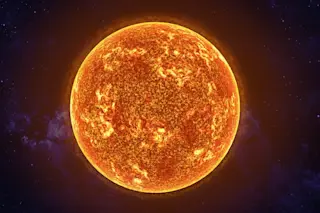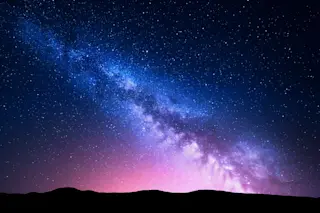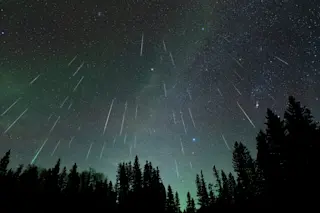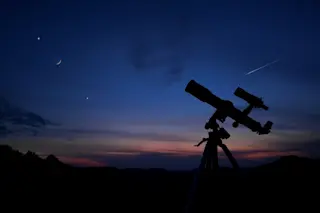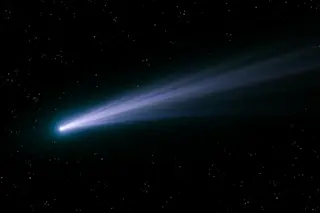Tonight when you look up at the sky—and I strongly urge you to do so—you can participate in three different kinds of amazing alignments.

A preview of tonight's lunar eclipse. (Credit: Martin Berner) One will produce a total lunar eclipse, as Earth’s shadow sweeps across the moon. One will produce the best view of Mars in more than 6 years, as the Red Planet makes its closest approach to Earth (technically that moment happened at 8:53AM EDT, but you couldn't have seen Mars then anyway). Both of these are beautiful celestial events with some unusual details. But there is also a third kind of alignment at work, one unlike any that has happened before. An alignment that does not depend on nice weather, clear skies, or any kind of specialized equipment. More on that in a moment. First, the eclipse. Most months the moon manages to dodge just above or below Earth’s shadow, but this month it plunges right through. The timing is a little rough for those of us who live on the East Coast, but the view will be spectacular. The curve of Earth’s shadow will start taking a bite out of the moon at 1:58AM EDT. Then at 3:06AM EDT the moon slips entirely into darkness. Even in complete shadow, the moon never really disappears. To understand why, imagine the view from the surface of the moon. There you would see a total eclipse of the sun, as Earth blocks out its light. You would also see a ring of red light all around the edge of the Earth. That is sunlight streaming through the atmosphere, tinted the red color of sunset. The ring of red light is, literally, every sunset on Earth seen all at once! Those sunset rays illuminate the eclipsed moon, coloring it a coppery or bloody red. To the naked eye the moon will look like a dull penny, with the darkest spot slowly migrating across the disk of the moon as it plows through the different parts of the shadow.
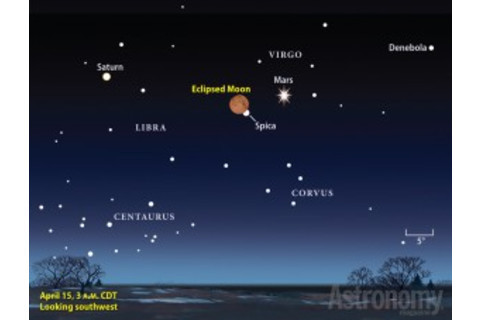
Where to look for the eclipsed moon and bright Mars tonight. (Credit: Roen Kelly) The eclipse will be a stirring spectacle even under hazy or partly cloudy skies, but a clear night will produce the best effect, of course. Then all you need is an alarm clock and some patience: The full visible part of the eclipse lasts about 3 ½ hours, although you can just wake up between 3AM and 4AM EDT to catch it at its peak. Binoculars enhance the view, letting you see the whole surface of the moon dimly dressed up in sunset colors. Nature has arranged a second easy sky spectacle for you. Mars is just 10 degrees away from the moon, a brilliant orange “star” that outshines any other point of light in the sky. The only way you can miss it is if you have cloudy skies. Because of Mars’s oval orbit, some alignments (formally known as oppositions) are closer than others. This one brings Mars closer, and hence brighter, than it has been since 2007. Now about that third alignment. For a half century now, NASA and the European Space Agency have been sending robotic probes to Mars, making increasingly precise maps of the planet’s exotic, rusty surface. (The Russians have been trying, too, but without much success.) You can access stirring imagery from those missions online. But now you don’t need to remain just a passive viewer; you can actively participate in the discovery process. A startup called Uwingu has launched a campaign to let ordinary citizens name the 500,000 largest known craters on Mars. The company charges a small fee for the naming process; the money goes to support The Uwingu Fund, which provides grants to support scientific research and education. That is a truly novel kind of alignment: an intersection of public Mars atlases; citizen science involvement; and private support of open-ended scientific inquiry. You can get started here. (Full disclosure: Discover and Astronomy magazines have worked to help promote Uwingu's projects, but we have no financial ties.)

Uwingu's Mars map lets you put your stamp on the Red Planet. (Credit: Uwingu) You may have heard some objection from the International Astronomical Union to the idea of charging to name craters on Mars. To my mind, that reflects an old, reactionary mindset. The IAU has no plans of its own to name those craters, nor does it have a meaningful scheme for involving the public in the process. It relies on a bureaucratic, top-down approach that is poorly suited to the public nature of much of today’s research, and to the sheer volume of information coming from the latest space probes. "When people name things they take personal ownership, which can only be good for interest in space and the sky," says Alan Stern, a former NASA director and founder of Uwingu. Today's close approach of Mars will be followed by another, even closer one in a little over two years. Tonight’s eclipse will be followed by three others (not as favorable for the United States, but pretty good all the same) over the coming year and a half. Naming a crater on Mars could also be the beginning of a far-reaching future set of events: the increasing direct involvement of the public in the exploration of the universe. Follow me on Twitter: @coreyspowell


